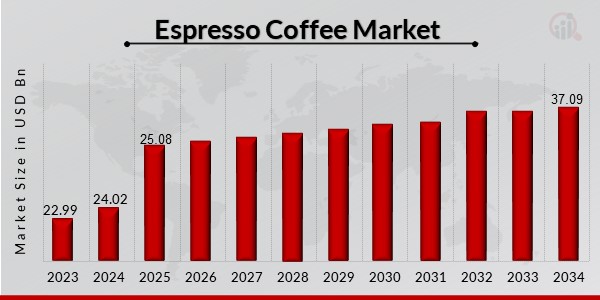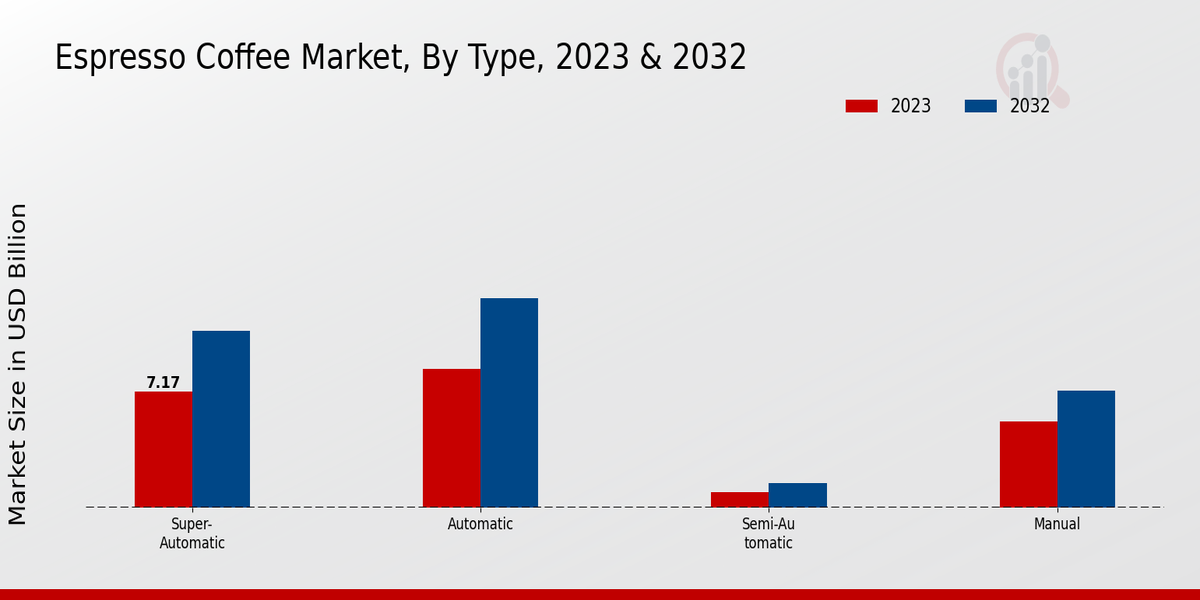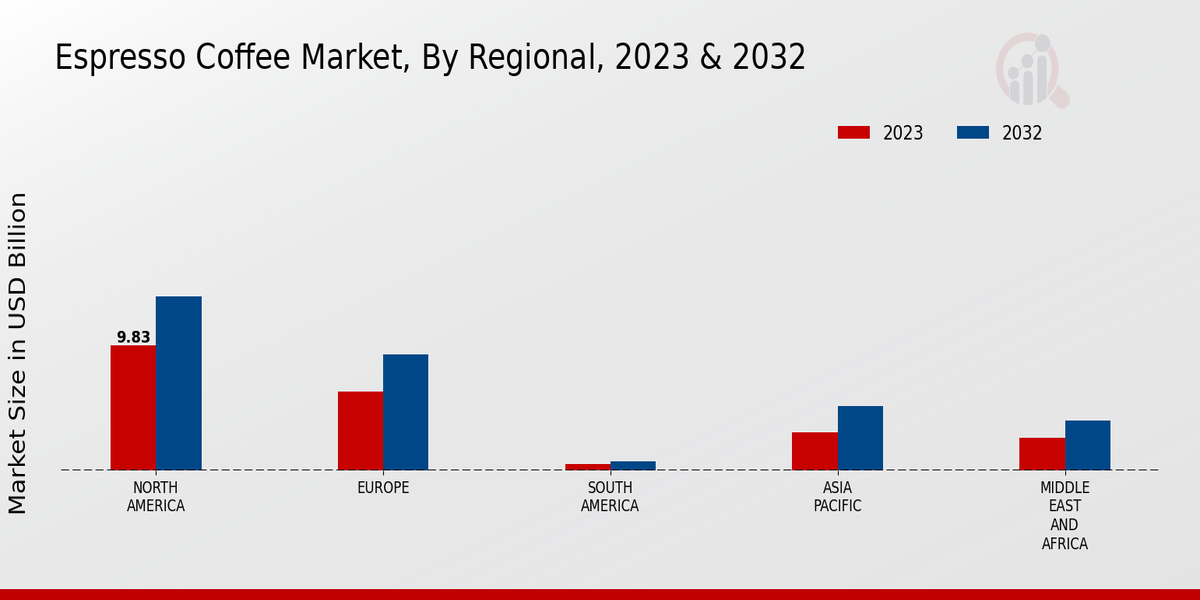Global Espresso Coffee Market Overview
Espresso Coffee Market Size was estimated at 24.02 (USD Billion) in 2024.The Espresso Coffee Industry is expected to grow from 25.08 (USD Billion) in 2025 to 37.09 (USD Billion) by 2034. The Espresso Coffee Market CAGR (growth rate) is expected to be around 4.4% during the forecast period (2025 - 2034).

Source: Primary Research, Secondary Research, MRFR Database and Analyst Review
Key Espresso Coffee Market Trends Highlighted
Espresso Coffee Market is very competitive and active under the influence of changing consumer preferences, technological advancements, and mushrooming specialty coffee shops. Specialty-based espresso drinks are witnessing increased demand as customers increasingly look out for premiumised and differentiated coffee experiences.Key drivers of the market entail expanding coffee culture, health advantages linked to moderate intake levels of filtered coffees and scaled-up specialty division. Among other things, growth prospects revolve around the innovative development of products that signal entrance into new markets and embracing sustainable production practices. Current developments include plant-based milk substitutes on the rise in addition to technology incorporation in brewing processes and, finally cold-brews as well as nitro-coffee gaining traction.
Espresso Coffee Market Drivers
Changing Consumer Preferences for Specialty Coffee
High demand for specialty coffee, such as espresso-based drinks, is a key driver for the growth of the Espresso Coffee Market Industry. With an increasing number of consumers looking for coffee experiences with high flavor and strong taste, espresso-based drinks are a perfect solution for this need. This trend is expected to continue to rise in the future and, therefore, will remain one of the key growth factors for the market. In addition, espresso coffee is seen as a more luxurious and sophisticated coffee drink with a stronger aroma due to the preparation method.Previously, espresso was consumed as an alternative to "traditional" filtered coffee; however, nowadays, it remains one of the central products in social places, where it has become increasingly popular at coffee shops and restaurants. The outlook of espresso coffee in cafes and restaurants fuels the interest in these drinks among consumers. Most significantly, the rise in popularity of specialty coffee drinks, including espresso coffees, led to an increased number of new brewing methods and coffee technologies.These solutions are promoting more frequent consumption of coffee experiences as they are easier and convenient to use, sometimes, available directly for use at home. These devices offer a more feasible and sometimes cheaper solution to drinking specialty coffee as compared to commercial products or services.
Rising Disposable Income and Urbanization
Rising disposable income and urbanization in emerging markets are also major factors that contribute to the growth of the Espresso Coffee Market Industry. As consumers in emerging markets obtain more and more disposable income, they tend to choose more premium products and premium lifestyles, such as specialty coffee. In addition, it is mostly happening in the urban regions, where more and more coffee houses and cafes. An emerging number of these establishments is explained by the rising trend for customers to visit coffee shops and socialize there.Thus, the rising number of establishments serve espresso-based coffee and drinks, which benefits the development of the market.
Expansion of Coffee Shop and Cafe Chains
The steady growth of coffee shops and cafe chains is another prominent driver of the growth of the Espresso Coffee Market Industry. These chains open additional locations in both developed and emerging markets where the number of experienced buyers will grow as espresso coffee becomes available. Their expansion also ensures that the quality of espresso coffee is reasonably standardized and that a specific level of quality is maintained by consumers.Finally, an increasing number of coffee shops and cafe chains offer a broader menu of espresso coffee and other espresso-based drinks, including specialized lattes, cappuccinos, and macchiatos. Their expansion will continue, and it remains one of the highly influential drivers of the growth of the Espresso Coffee Market Industry.
Espresso Coffee Market Segment Insights
Espresso Coffee Market Type Insights
The Espresso Coffee Market is segmented by Type into Super-Automatic, Automatic, Semi-Automatic, and Manual. The Super-Automatic segment holds the largest market share due to its convenience and ease of use. It is ideal for home users and small businesses that require high-quality espresso without the need for extensive training or expertise. The Automatic segment is also gaining popularity as it offers a balance between convenience and control. It is suitable for users who want more control over the brewing process than Super-Automatic machines but do not require the manual of Semi-Automatic or Manual machines.The Semi-Automatic segment is preferred by experienced users who enjoy the hands-on experience of crafting their espresso. It provides greater control over the brewing parameters, allowing users to customize their espresso to their desired tastes and preferences. The Manual segment is popular among coffee enthusiasts and professional baristas who demand ultimate control and precision in their espresso-making. It requires significant skill and practice to operate, but it offers the most flexibility and customization options. The Espresso Coffee Market revenue is expected to grow significantly over the next few years, driven by increasing demand for premium coffee experiences at home and in commercial settings.
Source: Primary Research, Secondary Research, MRFR Database and Analyst Review
Espresso Coffee Market Bean Type Insights
The Espresso Coffee Market segmentation by Bean Type includes Arabica, Robusta, and Blends. Arabica beans are known for their smooth, rich flavor and account for a majority of the Espresso Coffee Market revenue. In 2023, the Arabica segment held a market share of around 60%, and it is projected to continue dominating the market throughout the forecast period. Robusta beans, on the other hand, have a stronger, more bitter flavor and are often used in blends to add a touch of sharpness. The Robusta segment is expected to witness significant growth in the coming years due to its lower cost and higher caffeine content.Blends, which combine different types of beans to create a unique flavor profile, are also gaining popularity among consumers. The Espresso Coffee Market data shows that the Blends segment is projected to register a CAGR of 4.8% during the forecast period.
Coffee Market Roast Level Insights
The Espresso Coffee Market is segmented by Roast Level into Light Roast, Medium Roast, and Dark Roast. Among these, the Medium Roast segment holds the largest market share. In 2023, the Medium Roast segment was valued at 9.56 billion USD and is projected to reach 14.28 billion USD by 2032. The Light Roast segment is expected to register a CAGR of 4.2% during the forecast period, while the Dark Roast segment is expected to register a CAGR of 4.7%. The increasing popularity of specialty coffee and the growing demand for premium coffee experiences are driving the growth of the Espresso Coffee Market.Consumers are becoming more discerning in their coffee choices and are willing to pay a premium for high-quality, flavorful coffee. This trend is expected to continue in the coming years, fueling the growth of the Espresso Coffee Market.
Espresso Coffee Market Packaging Insights
The Espresso Coffee Market segmentation by Packaging comprises Whole Beans, Ground Coffee, Capsules, and Pods. Among these, Whole Beans held the largest market share in 2023, accounting for approximately 35% of the revenue. The convenience and affordability of Ground Coffee are expected to drive its growth, with a projected CAGR of 4.7% during the forecast period. Capsules and Pods are gaining popularity due to their ease of use and consistent quality, leading to a projected CAGR of 5.2% for Capsules and 6.1% for Pods. The rising demand for premium and specialty espresso coffees is driving the growth of the overall Espresso Coffee Market.
Espresso Coffee Market Flavor Insights
The Flavor segment holds a significant share in the Espresso Coffee Market revenue, with various sub-segments including Classic, Intense, Fruity, Floral, Chocolatey, and Nutty. Classic flavors dominate the market, accounting for over 40% of the market share. Intense flavors follow closely, with a market share of approximately 30%. Fruity flavors are gaining popularity, driven by the increasing demand for specialty and single-origin coffees, and are estimated to reach a market share of 15% by 2026. Floral flavors, reminiscent of jasmine or lavender, offer a unique and delicate taste experience and hold a market share of approximately 5%.Chocolatey and nutty flavors, known for their rich and indulgent taste, together account for nearly 10% of the market share. The diverse range of flavors in the Espresso Coffee Market caters to the varied preferences of consumers, contributing to its robust growth and popularity.
Espresso Coffee Market Regional Insights
Regionally, North America held the largest market share in 2023, accounting for over 35% of the market. Europe is the second-largest market, followed by APAC, South America, and MEA. The growth in the North American market is attributed to the increasing popularity of specialty coffee and the presence of major coffeehouse chains. The APAC region is expected to witness the fastest growth over the forecast period due to the rising disposable income and changing lifestyles in countries such as China and India. 
Source: Primary Research, Secondary Research, MRFR Database and Analyst Review
Espresso Coffee Market Key Players And Competitive Insights
Major players in the Espresso Coffee Market industry are constantly innovating and developing new products to meet the changing demands of consumers. Leading Espresso Coffee Market players are focusing on expanding their reach and increasing their market share. The Espresso Coffee Market development is being driven by the growing popularity of specialty coffee and the increasing demand for premium coffee products. The Espresso Coffee Market Competitive Landscape is highly competitive, with a number of major players vying for market share. Some of the key players in the Espresso Coffee Market include Nestle, Starbucks, Lavazza, Keurig Dr Pepper, and JDE Peet.Nespresso is a leading player in the Espresso Coffee Market. The company is known for its premium coffee products and its innovative coffee machines. Nespresso has a strong presence, and its products are sold in over 80 countries. The company is constantly innovating and developing new products to meet the changing demands of consumers. Nespresso is a major player in the Espresso Coffee Market and is expected to continue to grow its market share in the coming years.Lavazza is another major player in the Espresso Coffee Market. The company is known for its high-quality coffee products and its strong brand recognition. Lavazza has a presence, and its products are sold in over 140 countries. The company is constantly innovating and developing new products to meet the changing demands of consumers. Lavazza is a major player in the Espresso Coffee Market and is expected to continue to grow its market share in the coming years.
Key Companies in the Espresso Coffee Market Include
-
Groupe SEB
-
Starbucks
-
De'Longhi
-
Saeco
-
Nespresso
-
Jura Elektroapparate
-
Breville Group
-
Rancilio
-
Keurig Dr Pepper
-
Krups
-
JDE Peet's
-
Gaggia
-
Lavazza
-
Nuova Simonelli
Espresso Coffee Market Industry Developments
The Espresso Coffee Market is projected to grow from USD 22.01 billion in 2023 to USD 32.56 billion by 2032, at a CAGR of 4.44%. The increasing popularity of specialty coffee, the growing demand for convenience, and the rising disposable income in emerging markets are driving the growth of the market.Recent news developments in the market include the launch of new products by major players such as Starbucks and Dunkin' Donuts, and the expansion of the market into new regions such as Asia-Pacific and Latin America.
Espresso Coffee Market Segmentation Insights
Espresso Coffee Market Type Outlook
-
Super-Automatic
-
Automatic
-
Semi-Automatic
-
Manual
Espresso Coffee Market Bean Type Outlook
Espresso Coffee Market Roast Level Outlook
-
Light Roast
-
Medium Roast
-
Dark Roast
Espresso Coffee Market Packaging Outlook
-
Whole Beans
-
Ground Coffee
-
Capsules
-
Pods
Espresso Coffee Market Flavor Outlook
-
Classic
-
Intense
-
Fruity
-
Floral
-
Chocolatey
-
Nutty
Espresso Coffee Market Regional Outlook
-
North America
-
Europe
-
South America
-
Asia-Pacific
-
Middle East and Africa
spresso Coffee Market Report Scope
| Report Attribute/Metric |
Details |
| Market Size 2024 |
24.02 (USD Billion) |
| Market Size 2025 |
25.08 (USD Billion) |
| Market Size 2034 |
37.09 (USD Billion) |
| Compound Annual Growth Rate (CAGR) |
4.4% (2024 - 2032) |
| Report Coverage |
Revenue Forecast, Competitive Landscape, Growth Factors, and Trends |
| Base Year |
2024 |
| Market Forecast Period |
2025- 2034 |
| Historical Data |
2019 - 2023 |
| Market Forecast Units |
USD Billion |
| Key Companies Profiled |
Groupe SEB ,Starbucks ,De'Longhi ,Saeco ,Nespresso ,Jura Elektroapparate ,Breville Group ,Rancilio ,Keurig Dr Pepper ,Krups ,JDE Peet's ,Gaggia ,Lavazza ,Nuova Simonelli |
| Segments Covered |
Type, Bean Type, Roast Level, Packaging, Flavor, Regional |
| Key Market Opportunities |
Growing demand for specialty coffeeIncreasing consumption in emerging marketsExpansion of online and ecommerce channelsThe rising popularity of home brewingInnovations in flavor and variety |
| Key Market Dynamics |
Growing demand for premium coffeeRise in coffee consumption at home.Increasing popularity of specialty coffee shopsHealth benefits associated with coffeeTechnological advancements in coffee production |
| Countries Covered |
North America, Europe, APAC, South America, MEA |
Frequently Asked Questions (FAQ) :
The Espresso Coffee Market was valued at 24.02 billion U.S. dollars in 2024 and is projected to reach 37.09 billion U.S. dollars by 2034, exhibiting a CAGR of 4.4% during the forecast period (2025-2034).
North America is the dominant region in the Espresso Coffee Market, accounting for a significant market share. The presence of major coffee chains, such as Starbucks and Dunkin' Donuts, and the growing popularity of specialty coffee contribute to the region's dominance.
The key growth drivers of the Espresso Coffee Market include rising disposable income, increasing health consciousness, and the growing popularity of specialty coffee. Additionally, the expansion of coffee shop chains and the introduction of innovative products are contributing to market growth.
Some of the major competitors in the Espresso Coffee Market include Nestlé, JDE Peet's, Starbucks, Dunkin' Brands, and Lavazza. These companies are focusing on product innovation, expansion into new markets, and strategic acquisitions to maintain their market position.
◦ Emerging trends in the Espresso Coffee Market include the growing popularity of cold brew coffee, the increasing demand for sustainable coffee practices, and the rise of online coffee subscription services. Additionally, the use of technology, such as smart coffee machines and mobile apps, is enhancing the overall coffee experience.
The Espresso Coffee Market faces challenges such as fluctuating coffee bean prices, climate change, and competition from other beverage categories. Additionally, the rising cost of production and distribution can impact market growth.
The Espresso Coffee Market is anticipated to exhibit a steady growth rate during the forecast period, with a CAGR of 4.4% from 2025 to 2034.
Espresso Coffee finds applications in various sectors, including households, cafes, restaurants, and offices. It is used in preparing a wide range of coffee beverages, such as cappuccinos, lattes, and macchiatos.
Espresso Coffee is available in various types, including single-origin, blends, and flavored varieties. It can also be classified based on its roast level, such as light, medium, and dark roast.
The growth of the Espresso Coffee Market in the Asia-Pacific region is driven by factors such as rising disposable income, increasing urbanization, and the growing popularity of Western coffee culture. Additionally, the presence of a large youth population and the expansion of coffee shop chains are contributing to market growth.

















